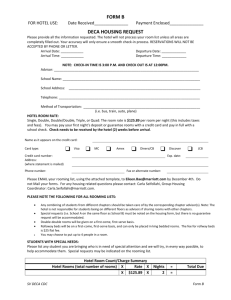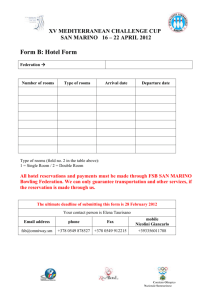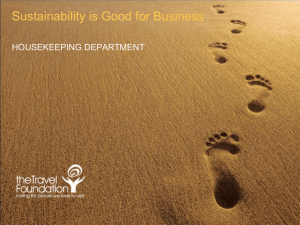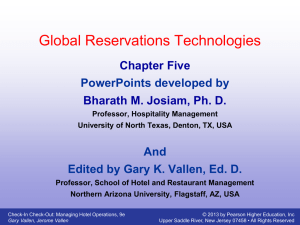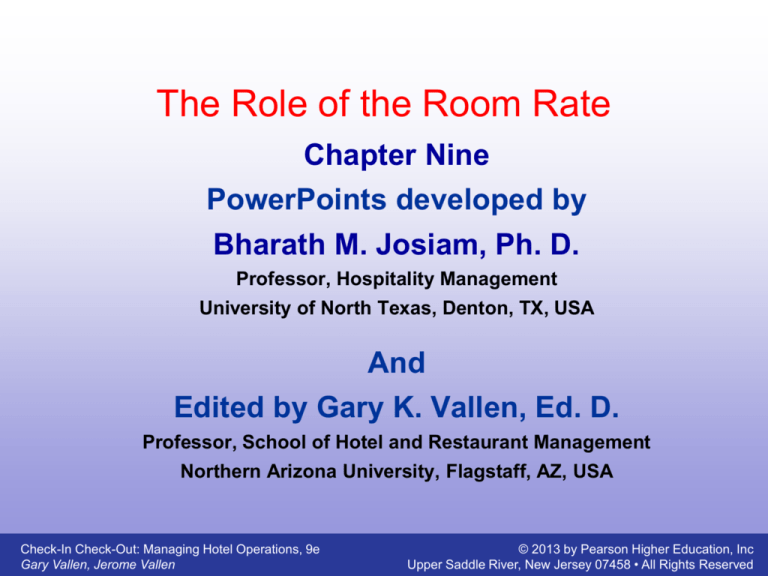
The Role of the Room Rate
Chapter Nine
PowerPoints developed by
Bharath M. Josiam, Ph. D.
Professor, Hospitality Management
University of North Texas, Denton, TX, USA
And
Edited by Gary K. Vallen, Ed. D.
Professor, School of Hotel and Restaurant Management
Northern Arizona University, Flagstaff, AZ, USA
Check-In Check-Out: Managing Hotel Operations, 9e
Gary Vallen, Jerome Vallen
© 2013 by Pearson Higher Education, Inc
Upper Saddle River, New Jersey 07458 • All Rights Reserved
Objectives of Chapter 9
• Understanding why hotels are unable to get the rack rate
• Understanding the negative impact on revenues from
discounting
• Understanding the Hubbart Room Rate formula
• Understanding the Building Cost Room Rate formula
• Understanding the Ideal Average Room Rate
• Understanding terms/jargon specific to room rate factors
and calculations
Check-In Check-Out: Managing Hotel Operations, 9e
Gary Vallen, Jerome Vallen
© 2013 by Pearson Higher Education, Inc
Upper Saddle River, New Jersey 07458 • All Rights Reserved
The Room Rate’s Impact on Guest Demand
• Hotel Room Rate and the Economy (Exhibit 9-1)
– Demand for hotel rooms generally reflect the economy.
• When economy is booming, demand shoots up, and hotels
charge more.
• When economy is weak, demand drops, as do occupancy,
ADR, and REVPAR.
– There is a lag between high demand and construction of new
hotel rooms.
• Booming economy leads to increased new construction, while
weak economy leads to bankruptcies and closures.
– Over time, this is equilibrium between supply and demand.
– But, capacity has also increased with over-built markets
– Room rate are price-elastic, but that varies with the market
segment targeted.
Check-In Check-Out: Managing Hotel Operations, 9e
Gary Vallen, Jerome Vallen
© 2013 by Pearson Higher Education, Inc
Upper Saddle River, New Jersey 07458 • All Rights Reserved
The Room Rate’s Impact on Guest Demand
• Bottom-Line
– You need to charge enough to make money, but not more than
your competitors, or you will “kill” the market
– Role of Lodging Taxes on Rates
• Politicians would rather tax visitors than locals!
– High taxes on hotel rooms world-wide as a result
– High taxes do impact business, particularly groups
– Online Travel Agencies (OTAs) and Room Taxes
• OTAs buy rooms at cheap wholesale rates and sell at higher
retail – that is how they make profits
– OTAs are only paying taxes on the lower wholesale rates
» Cities want them to pay taxes on the higher retail rates
» Individual hoteliers feel that there is unfair competition from
OTAs as hotels have to pay taxes at a higher rate to the cities
for their direct sales.
» Currently, there are many court cases across the country to
resolve this issue
Check-In Check-Out: Managing Hotel Operations, 9e
Gary Vallen, Jerome Vallen
© 2013 by Pearson Higher Education, Inc
Upper Saddle River, New Jersey 07458 • All Rights Reserved
The Room Rate’s Impact on Guest Demand
• Rack Rate: The standard posted rate
• Discounts off Rack Rate
– Most customers do not pay rack rate, so why bother?
• Some will pay, so lets get it from them!
• Rack rate sets the image/market position of the hotel
– This is a luxury hotel with “$200” room rates
– The impact of rate cutting (Exhibit 9-2)
• Discounting Profitability
– You need to sell 11% more rooms if you cut your rate by 10%
» Is the market that price elastic?
Check-In Check-Out: Managing Hotel Operations, 9e
Gary Vallen, Jerome Vallen
© 2013 by Pearson Higher Education, Inc
Upper Saddle River, New Jersey 07458 • All Rights Reserved
The Room Rate’s Impact on Guest Demand
• Discounts off Rack Rate (Continued)
– Examples of Discounted Rates
• Seasonal rates, weather-related discounts, weekly rates,
corporate rates, commercial rates, employee courtesy rates,
senior citizens rate, AAA or other travel club rates etc.
• Government per diems – The government will pay only a
fixed amount to its employee per day, so hotels charge less
for government employees to get that business
• It pays to pay rack rate – Give no discounts, but give special
benefits to those paying rack rate
• Auction Travel Sites – Deep discount on-line sites, where
customers bid for rates and hotels accept if they think the
room will be empty otherwise.
– Often “opaque,” where name of hotel is revealed only after bid is
final and credit card is charged. (Exhibit 9-9)
– Complimentary Rooms – No rate! Room is given free
• Have strict control systems in place to prevent abuse
Check-In Check-Out: Managing Hotel Operations, 9e
Gary Vallen, Jerome Vallen
© 2013 by Pearson Higher Education, Inc
Upper Saddle River, New Jersey 07458 • All Rights Reserved
The Room Rate’s Impact on Guest Demand
• Additional Rate Factors
– Energy and Other Non-room surcharges
• Charging per room
• Energy surcharges
• Resort fees
– Hotels can conveniently provide a range of “complimentary”
services, such as morning newspapers, local telephone
calls, in-room coffee, the health club, spa, etc.
• These fees appear to be on the decline
– A nuisance and source of complaints rather than a true
revenue source
– The growing potential for lawsuits
Check-In Check-Out: Managing Hotel Operations, 9e
Gary Vallen, Jerome Vallen
© 2013 by Pearson Higher Education, Inc
Upper Saddle River, New Jersey 07458 • All Rights Reserved
The Room Rate’s Impact on Guest Demand
• Additional Rate Factors (Continued)
– Premium Periods
• Ability to charge more than rack rate during “special”
events
– May be illegal and prosecuted as “price gouging”
– Double Occupancy
• Charging per person, rather than per room
– Trend in USA is to charge for the room, rather than per-person
– American Plan Day
• Guests on American plan (AP) or modified American plan
(MAP) must be given their full quota of meals
– Day Rate Rooms
• Special rates for stays of less than overnight
• Perceived as only for shady business and/or prone to
employee fraud and/or general accounting hassles
• Need to re-examine these perceptions
Check-In Check-Out: Managing Hotel Operations, 9e
Gary Vallen, Jerome Vallen
© 2013 by Pearson Higher Education, Inc
Upper Saddle River, New Jersey 07458 • All Rights Reserved
Determining the Proper Room Rate
•
The Hubbart Room Rate Formula
–
–
–
–
–
–
–
1.
2.
3.
4.
5.
6.
• (Exhibit 9-14)
Operating Expenses
1,102,800
Taxes and Insurance
273,000
Depreciation
294,750
Reasonable ROA
414,000
Total
2,084,550
Less Income from other sources
139,200
Amount needed from room sales
$ 1,945,350
Revenue from room sales needed
$1,945,350
Number of rooms available (Per Day)
88
Rooms available per year (item 2x 365)
32,120
Less allowance for vacancies (@ 30%)
9,636
Number of rooms to be sold (@70%)
22,484
ADR per room to get ROA (item1/item5)
$ 86.52
Check-In Check-Out: Managing Hotel Operations, 9e
Gary Vallen, Jerome Vallen
© 2013 by Pearson Higher Education, Inc
Upper Saddle River, New Jersey 07458 • All Rights Reserved
Determining the Proper Room Rate
•
The Hubbart Room Rate Formula
–
–
(Exhibit 9-14)
Short comings of the formula
• It is inward looking at what we need, rather than outward
looking at market conditions
• Many assumptions are problematic
– What is “reasonable” ROA?
– What occupancy rate is attainable?
» Occupancy is a function of room rate!!
– What about role of other departments like F & B?
» Should low estimates force us to increase rates?
» Should high estimates force us to lower rates?
–
Summary
• It is a worthwhile formula to use as a guideline, after
recognizing the problems inherent in it.
Check-In Check-Out: Managing Hotel Operations, 9e
Gary Vallen, Jerome Vallen
© 2013 by Pearson Higher Education, Inc
Upper Saddle River, New Jersey 07458 • All Rights Reserved
Determining the Proper Room Rate
•
Square Foot Calculation
–
Use numbers from Hubbart Formula, but use square footage of
room, not number of rooms
1.
2.
3.
4.
5.
•
Hotel has 27,250 square feet in 88 rooms
@ 70% occupancy only 19,075 sq,ft will be occupied
Daily required return is $ 5329.73
(Room revenue/365)
Each square foot must generate $0.27941 per day
(3/2)
A 300 sq.ft room would sell for $ 83.82
(4X5)
The Building Cost Room Rate Formula
–
The average room rate should equal $1 per $1,000 of
construction cost
•
•
–
A 200 room hotel, costing $14 million, should have a room rate of $70
($14 million /200 rooms/ $1,000) = $ 70
Despite being a very old “rule of thumb” it is surprisingly valid
even today!
Check-In Check-Out: Managing Hotel Operations, 9e
Gary Vallen, Jerome Vallen
© 2013 by Pearson Higher Education, Inc
Upper Saddle River, New Jersey 07458 • All Rights Reserved
Determining the Proper Room Rate
•
The Ideal Average Room Rate
– Assumes that at say 70% occupancy, each room category is occupied
at 70%
– Revenue is calculated based on this assumption
• If actual revenue is greater, there is demand for higher priced rooms,
so increase rates, or convert rooms to higher priced ones
• If actual revenue is lower, more lower priced rooms are being
occupied, so try up-selling, marketing etc to increase revenues
– In general, rooms fill from bottom-up, so we may need to construct
that way, with greater availability of cheaper rooms
•
Up-selling Premium Accommodations
– Use incentives to up-sell
– Higher ADRs are a win-win-win situation
• The clerk wins by receiving increased payroll
• Management wins because up-selling contributes proportionately
higher profits to the P&L Statement
• The guest wins by receiving exactly the room desired
Check-In Check-Out: Managing Hotel Operations, 9e
Gary Vallen, Jerome Vallen
© 2013 by Pearson Higher Education, Inc
Upper Saddle River, New Jersey 07458 • All Rights Reserved
Ideal Average Room Rate -Scenario 1
100%
Room Type
Single Room
Occupancy%
80%
90%
Single
Double
80%
Average
70%
Double Room
80%
60%
Junior Suite
60%
50%
Junior
Suite
Luxury
Suite
40%
Luxury Suite
60%
Average
70%
30%
20%
10%
0%
• Cheaper rooms have greater occupancy
• Rooms tend to be sold from “bottom-up”
– Train staff to upsell
– Consider converting larger rooms/suites to multiple single rooms
Check-In Check-Out: Managing Hotel Operations, 9e
Gary Vallen, Jerome Vallen
© 2013 by Pearson Higher Education, Inc
Upper Saddle River, New Jersey 07458 • All Rights Reserved
Ideal Average Room Rate - Scenario 2
100%
Room Type
Single Room
Occupancy%
90%
60%
80%
Junior Suite
Luxury Suite
Average
70%
Double Room
60%
60%
Junior Suite
80%
50%
Luxury Suite
80%
40%
Single
Double
30%
Average
70%
20%
10%
0%
• More expensive rooms have better occupancy
• Rooms are selling from “top –down”
– Potential to increase rates
– Potential to convert lower rated rooms into suites
Check-In Check-Out: Managing Hotel Operations, 9e
Gary Vallen, Jerome Vallen
© 2013 by Pearson Higher Education, Inc
Upper Saddle River, New Jersey 07458 • All Rights Reserved
Objectives of Chapter 9
• Understanding why hotels are unable to get the rack rate
• Understanding the negative impact on revenues from
discounting
• Understanding the Hubbart Room Rate formula
• Understanding the Building Cost Room Rate formula
• Understanding the Ideal Average Room Rate
• Understand terms/jargon specific to room rate factors and
calculations
Check-In Check-Out: Managing Hotel Operations, 9e
Gary Vallen, Jerome Vallen
© 2013 by Pearson Higher Education, Inc
Upper Saddle River, New Jersey 07458 • All Rights Reserved
Determining the Proper Room Rate – In-class Assignment
•
The Hubbart Room Rate Formula
–
–
–
–
–
–
–
1.
2.
3.
4.
5.
6.
• (Exhibit 9-14, pgs. 356, 357)
Operating Expenses
2,000,800
Taxes and Insurance
400,000
Depreciation
350,750
Reasonable ROA
900,000
Total
Less Income from other sources
340,000
Amount needed from room sales
$
Revenue from room sales needed $
Number of rooms available (Per Day) 275
Rooms available per year (item 2x 365)
Less allowance for vacancies (@ 25%)
Number of rooms to be sold (@75%)
ADR per room to get ROA (item1/item5) $
Check-In Check-Out: Managing Hotel Operations, 9e
Gary Vallen, Jerome Vallen
© 2013 by Pearson Higher Education, Inc
Upper Saddle River, New Jersey 07458 • All Rights Reserved
Determining the Proper Room Rate – In-class Assignment
•
Square Foot Calculation
–
Use numbers from Hubbart Formula, but use square footage
of room, not number of rooms
1.
2.
3.
4.
5.
•
Hotel has 80,500 square feet in 275 rooms
@ 75% occupancy only
Sq.ft are occupied
Daily required return is $
(Room Revenue/365)
Each square foot must generate $
per day (3/2)
A 300 sq.ft room would sell for $
(4X5)
The Building Cost Room Rate Formula
–
The average room rate should equal $1 per $1,000 of
construction cost
•
•
–
A 300 room hotel, costing $25 million, should have a room rate of $
($
million /
rooms/ $1,000) = $
Similar calculations can be done to arrive at a return on
investment for a major renovation project
Check-In Check-Out: Managing Hotel Operations, 9e
Gary Vallen, Jerome Vallen
© 2013 by Pearson Higher Education, Inc
Upper Saddle River, New Jersey 07458 • All Rights Reserved


